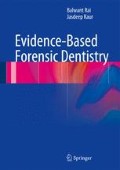Abstract
Forensic odontology is the application of dentistry to the investigation of crime and medicolegal investigations. It has its main applications in the identification of corpses and human remains and in bite mark analysis. This chapter focuses on the role of forensic odontology in identification and the scope and limitations of different forensic odontology techniques.
Access this chapter
Tax calculation will be finalised at checkout
Purchases are for personal use only
References
Ambrose JB (1989) Orofacial signs of child abuse and neglect: a dental perspective. Pediatrician 16(3–4):188–192
American Board of Forensic Odontology (1986) Guidelines for bite mark analysis. J Am Dent Assoc 112(3):383–386
Austin-Smith D, Maples WR (1994) The reliability of skull/photograph superimposition in individual identification. J Forensic Sci 39(2):446–455
Caldas IM, Magalhães T, Afonso A (2007) Establishing identity using cheiloscopy and palatoscopy. Forensic Sci Int 165:1–9
Cameron JM, Sims BG (1974) Forensic dentistry. Churchill Livingstone, Edinburgh
da Silva RHA, Sales-Peres A, de Oliveira RN, de Oliveira FT, Sales-Peres SH (2007) Use of DNA technology in forensic dentistry. J Appl Oral Sci 15:156–161
Frness J (1970) Cited in forensic odontology, report of BDA Winter Scientific meeting. Br Dent J 130(4):161–162
Gatliff BP (1984) Facial sculpture on the skull for identification. Am J Forensic Med Pathol 5(4):327–332
Hinchliffe J (2011) Forensic odontology, part 1. Dental identification. Br Dent J 210(5):219–224
Interpol (2008) Disaster victim identification. http://www.interpol.int/Public/DisasterVictim/default.asp. Accessed on 3/6/2010
Keiser-Nielsen S (1967) Editorial, News Letter. Scand Soc For Odont 1:4
Keiser-Neilsen S (1968) Forensic odontology. Int Dent J 18(3):668–681
Keiser-Neilsen S (1980) Person identification by means of teeth. John Wright & Sons, Bristol
Pretty IA, Sweet D (2000) Anatomical location of bitemarks and associated findings in 101 cases from the United States. J Forensic Sci 45(4):812–814
Rai B and Anand SC (2007a) Role of forensic odontology in tsunami disasters. Int J Forensic Sci 2(1). DOI: 10.5580/1c28. http://www. ispub.com/journal/the-internet-journal-of-forensic-science/volume-2-number-1/role-of-forensic-odontology-in-tsunami-disasters.html. Accessed on 6/6/2010
Rai B, Anand SC (2007b) Palatal rugae: in forensic examination. Indian Int J Forensic Med Toxicol 5(1):14–16
Rai B, Narula SC, Madan M, Dhatterwal SK (2004) Evidence of teeth in sex determination. Med Leg Update 4(4):119–126
Rai B, Anand SC, Dhattarwal SK, James H (2006) The value of dental record in identification. Ind Med Gaz 104(1):89–100
Rai B, Kaur J, Anand SC (2009) Mandibular third molar development staging to chronologic age and sex in North Indian children and young adults. J Forensic Odontostomatol 27(2):45–54
Rai B, Kaur J, Cingolani M, Ferrante L, Cameriere R (2010) Age estimation in children by measurement of open apices in teeth: an Indian formula. Int J Legal Med 124(3):237–241
Spitz WU (1993) Spitz and Fischer’s medicolegal investigation of death: guidelines for the application of pathology of crime investigation. Charles C. Thomas, Springfield
Sweet D, Pretty IA (2001) A look at forensic dentistry—part 2: teeth as weapons of violence—identification of bitemark perpetrators. Br Dent J 190(8):415–418
Vale GL, Noguchi TT (1983) Anatomical distribution of human bite marks in a series of 67 cases. J Forensic Sci 28(1):61–69
Valerie JR, Souviron RR (1984) Dusting and lifting the bite prints. A new technique, 1984. J Forensic Sci 19:326–330
Willems G (2001) A review of the most commonly used dental age estimation techniques. J Forensic Odontostomatol 19(1):9–17
Author information
Authors and Affiliations
Rights and permissions
Copyright information
© 2013 Springer-Verlag Berlin Heidelberg
About this chapter
Cite this chapter
Rai, B., Kaur, J. (2013). Forensic Odontology: History, Scope, and Limitations. In: Evidence-Based Forensic Dentistry. Springer, Berlin, Heidelberg. https://doi.org/10.1007/978-3-642-28994-1_1
Download citation
DOI: https://doi.org/10.1007/978-3-642-28994-1_1
Published:
Publisher Name: Springer, Berlin, Heidelberg
Print ISBN: 978-3-642-28993-4
Online ISBN: 978-3-642-28994-1
eBook Packages: MedicineMedicine (R0)

